And even if you find appropriate place for the system, it is far from a fact that your neighbors will like it. The task can be made easier by following some recommended steps.
Step #1
First you need to determine exactly how many people will permanently live in the house. It is generally accepted that on average, a family of four people (two adults and two children) consumes up to 10 cubic meters of water per month.
It is clear that each person is individual and the error in calculating the volume of sewage for the whole family is inevitable. It doesn't matter - equipment developers have their own standards.
Each household cleaning system Wastewater has a certain performance: it is measured in m3 / day (as well as l / s). By linking people and productivity, a starting list of possible technical solutions can be prepared.
Step #2
What's next? Of course, mother nature: she imposes a number of very strong restrictions, the most important of which is the material for the manufacture of the storage tank of the treatment system. The choice is quite simple: plastic, reinforced concrete or steel.
- Plastic is very light (does not require a hoist for installation), does not rust, has a long service life. correct operation. But it withstands relatively little soil pressure (like sand) and is prone to being pushed out of the ground in the spring (it must be laid on concrete slab).
- Reinforced concrete has the longest service life (more than half a century), does not corrode, is not pushed out by groundwater. But it is heavy (a truck crane is needed for installation) and requires large volume produced earthworks.
- Steel is stronger than plastic and lighter than reinforced concrete. But it cannot be covered with excavated soil ( possible deformation), it rusts, and ground water can push the system out.
Step #3
If the treatment plant is laid in a place where winter is one of the key seasons, then it is necessary to remember the depth of soil freezing. Although the waste liquid will be clearly warmer than air or earth, it is not infinitely resistant to frost, therefore it is recommended to provide insulation of sewer pipes in the ground with foam. Careful reading of the documentation for the equipment will help to avoid many unnecessary problems.
Step #4
The waste liquid entering the sewer is complex in composition: it includes water, solid fractions, dissolved substances (fats, salts, carbohydrates, etc.).

Wastewater treatment plant through various chemical, physical and biological methods separates everything from the water. As a result, a drain with the required indicators is output to the outside.
The options for discharging the purified (clarified) liquid are obvious:
- roadside ditch,
- swamp,
- drainage well or a filtration (absorption) field.
If everything is really bad with them, then for sure you will have to significantly revise the list of possible technical solutions.
Step #5
An essential parameter is the depth of the exit from the main house sewer pipe: as a rule, it is rigidly fixed by the structure. Doesn't fit? Then the problem is solved by increasing the neck. Only in some cleaning systems with a pipe can something be done without resorting to additional expenses.
Step #6
It is necessary to take into account which residence prevails - permanent or temporary. This is important because some wastewater treatment plants operate on bacterial colonies that feed on wastewater. If the "animals" remain hungry, they may hibernate or die. In this case, you will spend 2-4 weeks to bring the system back to normal working condition.
Be aware that septic tanks and some biological filtration plants can reach a relatively acceptable level of performance immediately.
Step #7
Often the biological principle of cleaning is effective only when the use of cleaning agents and other preparations that are toxic to microorganisms is limited. Therefore, it is useful to know as much as possible about undesirable substances before buying a particular one. cleaning system.

Step #8
Some questions about the operation of the equipment are better to clarify in advance. For example:
- Will the unit work if the volume of wastewater exceeds the nameplate capacity by 10-20%, which is very likely in everyday practice?
- What happens in the event of an uneven supply of wastewater?
- How long does it take for a sewage treatment system to reach its intended performance level after a downtime?
- How effective and safe is the dirty liquid removal scheme?
Step #9
Another factor is the power supply: as a rule, you have to install additional equipment, for example: a drainage or fecal pump with a grinder.
There can be many reasons:
- site topography,
- principle of operation of the cleaning system,
- power outages.
Step #10
The sewage treatment system, of course, must be maintained - this means new costs (time and money).

Arises complex issue: needed expendable materials- what kind, how often and in what volume? Individual nodes sometimes fail: what is necessary to change, what is desirable; what is the easiest way to solve the problem? And the last: the frequency of sediment removal - what?
Undoubtedly, the design of the installation must provide convenient and safe access for scheduled and unscheduled maintenance. The more complex the equipment, the less reliable it is.
Step #11
The choice is almost made: there are very few left.
Be sure to have a hygienic conclusion and a certificate of conformity. Evaluate warranties: Ideally, they should cover both hardware and installation work(including installation supervision). And ask contractors for the appropriate licenses.
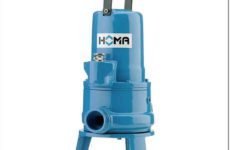
For country house it is important to have all communications that will make the life of those living in it comfortable, high-quality and modern. And the point here is not only in the water supply system and electrical communications. Autonomous sewerage also contributes to the improvement of a detached cottage. For those who do not yet understand what autonomous sewage is, our material is below.
Autonomous sewerage is a system for the removal and collection of sewage from the house and all residential / household premises. In the case of using modern species sewer systems, drains can be additionally cleaned and drained into the ground, which increases not only the efficiency of communication in a private house, but also allows you to take care of the environment.
Important: wastewater, even in small quantities, constantly penetrating into the ground, can cause irreparable harm to aquifers that lie close to the surface. And this means that the water from your well and the neighbor's well is not subject to use in accordance with sanitary standards.
Types of sewer system for a private house
For device autonomous sewerage can be used in the countryside different types and types sewer facilities. So, according to the method of collecting and treating wastewater, sewer systems can be divided into such.
Cesspool
The easiest way to set up a system private sewer. It was used by our ancestors and today in some cases it is used in summer cottages for infrequent use of the water supply system and toilet.
Such a private sewerage system is a pit dug in the ground with even smooth walls. Sometimes, in order to prevent possible soil shedding, the owners of a summer house or cottage lay out walls cesspool brick or cinder block like a checkerboard masonry, leaving small gaps in places. These holes allow waste water to go into the ground.
Important: the installation of such an autonomous sewer in Russia is prohibited and is a criminal offense, since it represents real threat environment.
Such an autonomous sewage system has one single advantage - a minimum of funds for its arrangement. However, the number of shortcomings in such a private sewage system is numerous. These are:
- The need to attract special equipment in the event that the pit will be large or large labor costs for the formation of a cesspool;
- Clear bias to the side gross violations sanitary and epidemiological norm according to SanPin;
- The presence of a sharp and unpleasant odor in the area as a result of the accumulation of sewage in the pit;
- The need for monthly involvement of sewage equipment for pumping wastewater from the pit;
- High risk of water pollution in a well or well and, as a result, toxic poisoning of all relatives and neighbors in the area;
- The impossibility of using such an autonomous sewage system in those areas where swampy soils or observed presence in the ground a large number peat, aquifers close to the surface, sand or sandstone.
Sealed storage
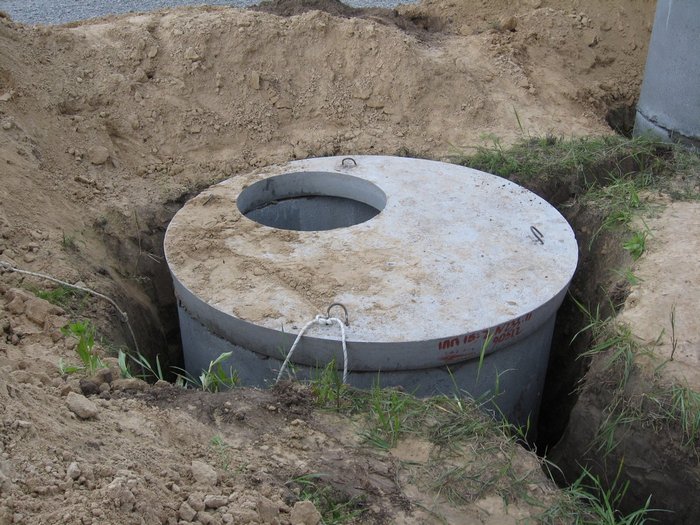
This type of sewage is also an analogue of a cesspool, with the only difference being that such a storage tank is completely sealed. That is, after digging a hole, it is completely equipped in such a way that the drains in no way seep into the ground. For the installation of a sealed autonomous sewer by type, the drive is often used:
- Standard concrete rings, which are mounted one on one in height, reliably sealing the joints with sealant and mastic. A cover with a hatch is laid on top.
- Plastic tanks by barrel type. In this case, the container must be well anchored in the ground, otherwise it may be washed away and floated out of the soil under the influence of groundwater.
- Old car tires. They are used if the autonomous sewage system is supposed to be small. Here it is important to carefully seal the joints of the tires.
- Habitual summer resident brickwork solid wall with concrete bottom.
All these materials form a sealed chamber for collecting sewage in it. The principle of operation of such an autonomous sewage system is simple. First, all drains are sent by gravity to the reservoir, where they accumulate to a certain volume. As soon as the volume of the storage chamber of such a private station is filled, you have to invite a sewage machine to drain the tank.
Important: the sealed storage must have a correctly calculated volume, otherwise the vacuum truck will have to be called too often.
Benefits of sealed storage:
- Safety for environment;
- The ability to arrange such autonomous sewage systems on the site without violating the landscape design.
Such a structure also has disadvantages:
- A large amount of work during the installation of the drive;
- The need to clean the tank at regular intervals;
- Possible presence of an unpleasant odor in the area at the time of pumping wastewater from the storage tank.
Important: you need to choose the material for the equipment of a sealed storage tank carefully, based on financial capabilities and specifications the material itself.
Mechanical septic tank
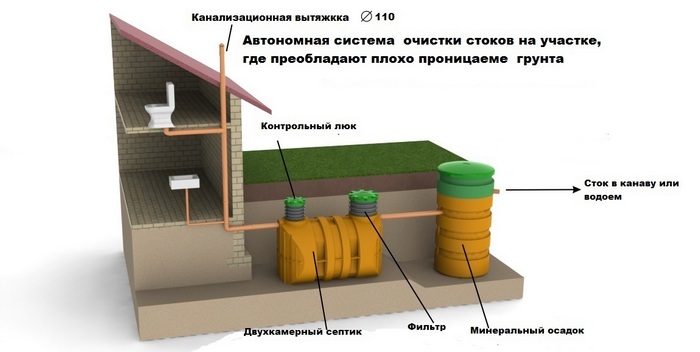
This type of autonomous sewer is a more advanced facility for sewage treatment. The design of a mechanical septic tank consists of 2-4 working chambers, in each of which there is a phased treatment of wastewater. As a result, the drains clarified in this way completely go into the ground. Once every six months or a year, the owner remains to clean the septic tank chambers from the sludge accumulated in them with the help of a sewer.
Important: a mechanical septic tank is not suitable for areas where groundwater is too high. There is a risk of waterlogging the soil or washing away the house.
The principle of operation of such a treatment system is to settling water and the precipitation of large heavy debris at the bottom of each of the chambers. As a result, lighter water each time flows by gravity into the next tank, eventually reaching the ground.
Important: the more chambers in a mechanical septic tank, the cleaner the water will be at the outlet. On average, wastewater treatment in this way allows you to get water purified by 70%.
Advantages of a mechanical septic tank:
- Relatively economical expenditure of funds for its construction;
- The possibility of equipping your own sewage system on a site with a well or well (provided that it is located at a distance of 20 or more meters from the source);
- Full energy independence, which means that the water purification system can be arranged on suburban area without power supply;
- Complete absence unpleasant odors from the septic.
However, this system also has its drawbacks:
- The complexity of work on the arrangement of a septic tank;
- The need for technical inspection of tanks and their cleaning at intervals of a year, as well as the need for periodic replacement of the sand and gravel filter in the last drainage chamber;
- Possible overflow of wastewater in case of incorrect calculations of the first storage chamber.
Local wastewater treatment plants
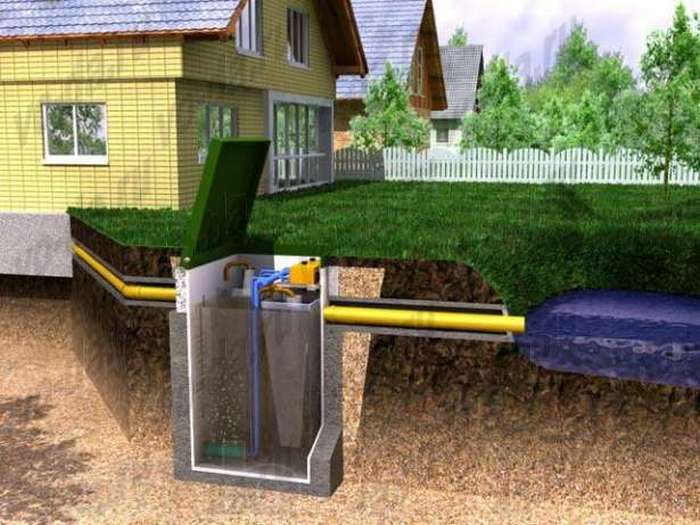
For the installation of an autonomous sewer, you can also use special autonomous stations designed and manufactured specifically for the collection and processing of sewage. Such a system is a monolithic tank on the outside, divided inside by partitions and an overflow system into three, four, or five compartments. The chambers are equipped with special pumping devices, facilitating the overflow of clarified waters. In addition, an autonomous wastewater treatment plant is equipped with special biological filters, which allows wastewater treatment using aerobic or anaerobic bacteria. Bacteria contribute to the rapid decomposition of domestic wastewater into simple components (water, methane, nitrates and nitrites), which makes wastewater clarification more effective.
Important: autonomous stations with bacterial filters and with a system biological treatment wastewater allows you to get clarified up to 95% water at the outlet. And this, in turn, is a direct concern for the environment, since such water can be dumped directly into water bodies, storm sewers or spend on watering garden crops.
The advantages of such a system:
- High degree of water purification;
- Long service life of the station (from 50 years or more);
- The possibility of arranging a private sewage system without violating the overall landscape design;
- Ease of installation and maintenance of the system;
- The complete absence of a characteristic smell in the area.
The only disadvantage of such a station is its price. However, the cost of the cleaning system fully pays off already in the first two years of operation.
Important: choose the type of autonomous sewage system for suburban area it is necessary based on personal requirements for the comfort of living in a cottage, the total volume of drains, the regularity of using sewage and the size family budget. But, by no means to the detriment of the environment.
Today sewage treatment systems widely used throughout Russia in households and enterprises for various purposes. the main task equipment consists in the complex treatment of wastewater for the purpose of subsequent discharge into the ground or a reservoir. There are 3 types of such installations:
- Aerotank.
- Septic.
- Sealed storage.
The choice of installation is determined by many factors. For example, these include the geological features of the installation site, the expected frequency of operation, or compliance with regulations. environmental safety. The cost of the system also plays an important role.
Aerotank is an effective biological treatment system
Aerotank is an installation that is capable of short term treat a sufficiently large volume of wastewater. The drains passed through the equipment do not require additional post-treatment. Filtered water can be immediately discharged into the ground or reservoirs. The installation of the system does not depend on geological features terrain and groundwater levels.
Septic tank - multi-chamber equipment with a lot of advantages
A septic tank is an autonomous sewage treatment system, which is produced according to the multi-chamber principle. Usually the equipment contains 2 or 3 cameras. It is there that wastewater is settled and cleaned with the help of anaerobic bacteria. Then the water goes through a post-treatment procedure through a soil filter. To organize the process, installation of filtration fields and wells for drainage is required.
Key benefits of septic tanks
- Quick installation - the most difficult part of the activities is the arrangement of the pit. Installing the equipment usually does not cause any problems.
- High strength– the body of the system is made from durable material designed for a long stay in the ground.
- Wide selection – modern septic tanks are presented by the big range of models that allows to pick up the necessary equipment easily.
- Complex cleaning - Subject to compliance with the operating rules, the system effectively copes with wastewater filtration.
- Independence from geological conditions- a septic tank can be installed in any area, since its body is characterized by complete tightness.
Sealed storage - a simple and convenient way to collect wastewater
A sealed reservoir is a reservoir where sewer water accumulates, which is periodically pumped out and taken by special vehicles. This option is mainly used in buildings with a small amount of daily effluents. The storage tanks are equipped with filling sensors that monitor the level of waste water and signal the need to pump it out.
Basic sewerage treatment methods
There are 3 filtration methods used in sewage treatment systems. We are talking about chemical, mechanical and biological. Each of the methods has its own characteristics, which largely determine the area of use and other important aspects equipment operation.
Chemical wastewater treatment
Cleaning is based on reagents that, by chemical reactions convert dissolved impurities into insoluble ones. At the end of the process, the substances precipitate. This method mainly used for filtering wastewater at industrial facilities.
Mechanical wastewater treatment
Cleaning solves several important problems at once. First, the removal of mineral waste. Secondly, the elimination of foreign objects that accidentally fall into sewer system houses or buildings.
Purification comes down to filtering and settling sewage. Note that mechanical cleaning does not remove organic compounds. For this reason, it often precedes biological cleaning.
Biological wastewater treatment
The method is based on the use of bacteria, which are divided into 2 types - aerobes and anaerobes. The first for normal life constantly requires oxygen. The latter, on the contrary, reproduce in an oxygen-free environment. Accordingly, biological treatment is aerobic and anaerobic.
Modern treatment facilities involve the use of both types of bacteria at once. The cleaning process is as follows. Initially, effluents enter tanks with anaerobes, where they are oxidized for 2-3 days. After that, wastewater is transported to other tanks for aerobic post-treatment.
Biological treatment removes organic compounds and harmful bacteria from wastewater. Thus, the sewage treatment system brings water into line with established norms and makes it possible to divert it into the ground or nearby water bodies.
Treatment facilities from TD " Engineering equipment" – effective cleaning domestic, storm and melt waste water!
Modern autonomous biological system cleaning type NV is manufactured by TRAIDENIS () in Europe
At the same time, for more than thirty years, this installation (sewerage of a private house) has been proving its efficiency even in harsh winter conditions. northern Europe. This is an example of how it should work aerobic facilities in action, not empty promises. Its reliability, proven over the years of operation, is a real guarantee of performance in Russian conditions.
Where there is no possibility of connection to the central sewers (private houses, dachas, cottages) - it is possible to install an autonomous private sewerage systems (outdoor sewerage ) — systems biological treatment of sewage effluents type NV production Tridenis . VOC (local treatment plant) – real alternative septic facilities that do not harm the environment.
Cleaning system drains type NV (wastewater treatment) is a cone special form from two containers built into each other. The center of the installation is occupied by honeycombs made of a patented material (an alloy of polyethylene and polypropylene). It is in them that colonies of aerobic bacteria are involved in the process of decomposition of polluted effluents into nitrogen, water, carbon dioxide(CO 2) and a small amount of waste sludge (high degree of purification) , get the opportunity to eat and develop. The operation of the installation consists in the constant sprayed circulation of contaminated wastewater through the central compartment filled with honeycombs with colonies of microorganisms. (biological treatment) . Water treated in this way by 96-98% is removed from the plant, the waste sludge settles to the bottom. In the outer cone, the water undergoes post-treatment with anaerobic and anoxic bacteria. Fully purified water is drained.
Thus, the issue of sewerage of a house, cottage, village and other non-sewered objects is solved. One answer: standalone local sewerage.
Three types of autonomous biological systems type NV currently produced:
1. NV-A - standard version, wherein excess sludge it is pumped out of the reactor with the help of external equipment (sewage truck);
2. special bags for excess activated sludge and completely independent of external devices.
3. completed with a sludge concentrator. Completely independent of external devices.
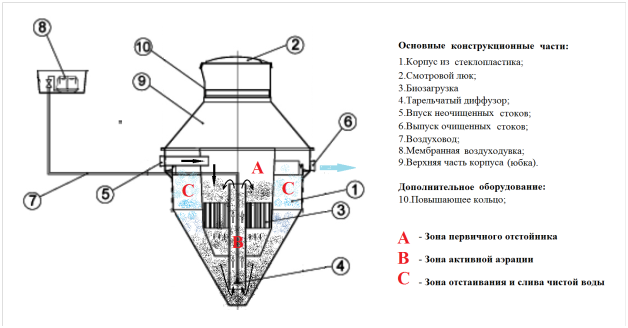
Installation of biological sewage treatment(Sewage machine). Sewerage of a private housetype NV
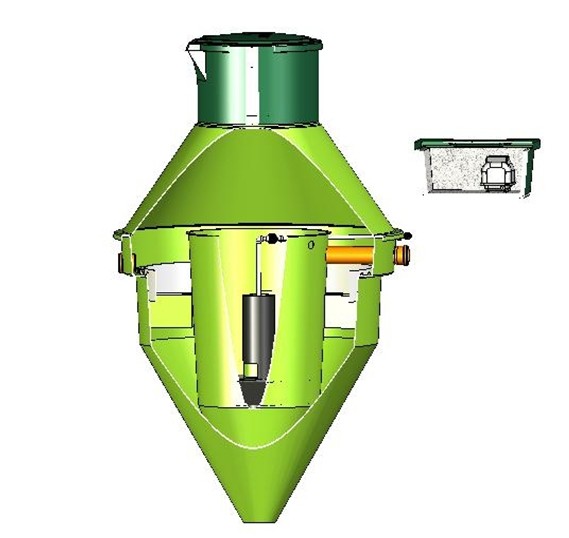
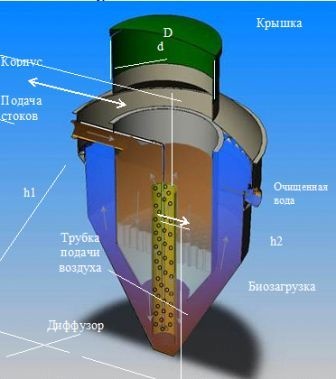
Technical details
|
||||||||||||||||||||||||||||||||||||||||||||||||||||||||||
Rules for the operation of a structure of this type
NV system (sewage machine), unlike other similar systems absolutely maintenance-free. After many years of experience in exploiting our data systems , a list of recommendations has been developed that must be followed in order not to lose the manufacturer's warranty.
Uniqueness systems
NV is that efforts for its maintenance do not need to be applied at all. The only condition for maintaining the guarantee for its work will be the following simple rules. They will be the key to the safety of your investment. in autonomous system cleaning
Namely:
- The blower is installed in a dry and ventilated place (room). If this possibility is absent, it is necessary to protect it as much as possible from external influences (sealing).
- From time to time check whether the blower is running and connected to the mains. In normal condition, it does not overheat and does not vibrate during operation. Filters must be clean. Once every two years, it will be desirable to replace the working membrane (its cost is about twenty dollars).
- Once a year, or two years (depending on the workload systems ) you will need to pump out the sludge - with a sewage machine, a special bag, or into a sludge tank.
- Remove (open) the lid of the unit every time you check the performance, or when pumping out excess sludge.
Avoid entering the sewage treatment plant:
- surface runoff ( surface runoff - water from roofs, plots, etc.);
- drains from garages, or other non-domestic premises;
- water from pools or other open containers with a volume of more than one cubic meter;
- chemicals not intended for entry into systems sewerage, such as: refined petroleum products, agrochemicals and other aggressive chemicals;
- water that has undergone a regeneration cycle in softening (cleaning of iron impurities) household filters.
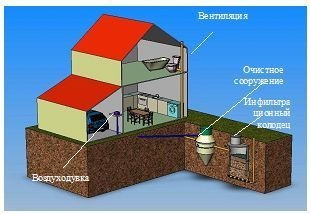
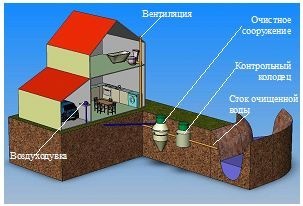
Human life is inextricably linked with water. Therefore, in the construction of housing, one of the first concerns is the construction of a water pipe. But if water is supplied to the house, then you need to take care of the disposal of wastewater. In order to recycle used water and to keep the soil and water clean, wastewater treatment systems must be used. Let's consider what installations can be used for sewerage equipment in a private house.
Today, few people are satisfied with the prospect of living in a house devoid of amenities, even if it is just a dacha. Most owners strive to make their home as comfortable as possible: organize heating, conduct water into the house.
But if there is a water supply system, then a sewerage system is also needed - a system for diverting and processing wastewater. Since not all suburban villages have centralized system collection and processing of domestic wastewater, then a local wastewater treatment system is being built.
Wastewater treatment methods
To clean domestic sewage, as a rule, the following cleaning methods are used:
- Mechanical - settling, filtering.
- Biological - processing of wastewater by microorganisms.
In nature, there are two types of bacteria that can effectively clean drains:
- Anaerobes are microorganisms that carry out their vital activity without oxygen.
- Aerobes are bacteria that do not "work" in an oxygen-free environment.
As practice shows, it is possible to achieve the greatest effect in wastewater treatment if a combination of several treatment methods is used. The modern treatment system provides for the initial settling of wastewater, and then their biological treatment using anaerobes and aerobes.
Anaerobic septic tanks
A septic tank is an installation in which drains go through several phased stages of treatment. The principle of operation of a septic tank is to settle wastewater and process organic matter by anaerobic bacteria. To achieve best quality septic tanks are made multi-chamber. The main part of the solid waste settles in the first chamber, and pre-purified water flows into the subsequent chambers.

Organic inclusions, which make up most of the pollution of domestic sewage, decompose under the action of anaerobic bacteria. Organics decompose into simple components - methane and water, and insoluble residues settle to the bottom of the chambers.
Treatment of wastewater with aerobic bacteria begins after it leaves the septic tank and enters the aeration fields - devices necessary for post-treatment of wastewater. On aeration fields, wastewater is additionally filtered, passing through a filter made of sand and gravel. Thus, after going through all the stages, the water is purified by almost 100% and does not harm the environment.
Cleaning steps in an anaerobic septic tank
- Stage one. It is carried out in the primary sump. There is a process that is commonly called clarification of drains. In the first chamber, the contaminated water is separated into specific gravity. Particles that have a heavy weight settle to the bottom, inclusions that are lighter than water rise to the top. In the center of the primary clarifier, where the overflow pipe to the second chamber is located, clarified effluents are collected. Settling continues in the second chamber, only here the sedimentation of smaller inclusions, which are in the liquid in suspension, is already taking place.
Advice! Septic tanks are built in such a way that drains from chamber to chamber flow slowly. Only at a low speed of movement is it possible to ensure high-quality sedimentation.
- The second stage is biological. Settled to the bottom organic matter are biodegraded by anaerobic bacteria. During the fermentation of the sediment, heat is released, so the temperature in the septic tank is always elevated. This circumstance allows the use of septic tanks not only in summer, but also in winter.

- The last stage of cleaning takes place on the filtration fields. The effluents clarified in the septic tank are supplied here through pipes. Holes are made in the pipes through which water seeps into the soil filter. Passing through a layer of sand and gravel, the water is filtered. In addition, it is additionally cleansed with the help of aerobes that live in the soil.
Aerobic type septic tank
In addition to traditional septic tanks, today they are widely used modern systems biological wastewater treatment - VOC, additionally equipped with aerators. In such stations, wastewater is alternately processed by anaerobic and aerobic bacteria, as a result, at the outlet of the treatment plant, the water is 98% purified, so there is no need to build filtration fields.
Water purified in VOCs can be discharged onto the ground or into the nearest body of water without harm to the environment. If necessary, water can be directed to a storage well for domestic use, such as lawn or garden irrigation.
Stages of wastewater treatment in aerobic septic tanks
- The first stage is upholding. Just like in conventional septic tanks, the VOC uses such a simple but reliable mechanical way cleaning.
- The second stage is the processing of the sludge by anaerobic bacteria. Organic matter that has fallen in the form of a precipitate is processed by anaerobic bacteria. That is, up to this point, there are no differences in the operation of a simple septic tank and VOCs.
- The third stage is processing with the help of aerobic bacteria. When the aerator is turned on in the chamber, the stage of aerobic cleaning begins. In an environment saturated with oxygen, bacteria efficiently and quickly process most of the organic inclusions.

- Stage four - again upholding. After aerobic treatment of wastewater, water enters the secondary clarifier, where the insoluble sediment - sludge - settles. Purified water enters the outlet, and activated sludge is reused in the purification process. As excess sludge accumulates, it will need to be removed from the sump.
Simple septic tank or VOC?
What kind of wastewater treatment system should be preferred during construction local sewerage? There is no single answer to this question. When choosing an installation, local conditions will need to be taken into account. Let's spend a small comparative analysis septic tanks and VOCs:
- Space required for installation. To install a modern VOC, as a rule, one or two square meters area. If you need to install a septic tank, you will need big square. The septic tank itself is somewhat larger than the VOC, but the main area will be required for the construction of filtration fields necessary for the post-treatment of wastewater.
- Geological characteristics of the site. If it is decided to install a VOC, then the geological characteristics of the site can only affect the choice of VOC modification. And here is the device of the filtering fields on clay soils is an intractable task.
Advice! If soil water is high on the site, then you should purchase a VOC with forced drainage, that is, equipped with an additional pump.
- Autonomy. If the septic tank is completely offline installation, the VOC requires power to operate.
Advice! If the local sewerage system is equipped with a volatile wastewater treatment plant, then during a power outage it is necessary to reduce the use of water to a minimum. Otherwise, overflow of the chambers may occur, since the pumps pumping wastewater do not work.
- Service. Both a conventional septic tank and VOCs need regular maintenance. The septic tank will have to be cleaned of accumulated sediment about 1-2 times a year using sewage equipment. The cleaning of the sludge collector in the VOC should be carried out more often - about once a quarter, but this work can be easily done on your own.
Advice! When choosing a place to install a septic tank, you need to take into account the need to clean it and leave free passage for the sewer truck.
- Price. A conventional septic tank is cheaper than VOCs. However, it is necessary to take into account the cost of building filtration fields, as well as the fact that filtration fields last no more than 10-12 years, after which they need to be changed.
Design
Having decided on the type of treatment plant, you can begin designing drainage systems for a country house. Most often, the project is made simultaneously with the project of the house. But if a building that has already been put into operation is being improved, then a sewerage project for a private house is drawn up separately.

When designing a wastewater disposal system, local conditions must be taken into account. Therefore, before starting design work geological exploration is recommended, during which the following points will be clarified:
- features of the relief of the site;
- characteristics of the soil, to select the method of water drainage, it is necessary to assess the absorbency of the soil;
- the level of location and seasonal rises of groundwater.
Before the development of a project for a drainage system for a home is started, the following points need to be clarified:
- average daily water consumption in the house;
- frequency of use - year-round or periodically.
After collecting information, you can begin to draw up a project.
Tilt angle
An important point is the angle of inclination of the pipeline. This point is important in the construction of gravity systems. If it is impossible to comply with the required angle of inclination, it is necessary to plan the construction pressure system, in which wastewater is pumped using a fecal pump.
Many home craftsmen who take on self-assembly, underestimate this point, and meanwhile, errors in both directions reduce the efficiency of the system.

If the angle is not large enough, then the flow will move through the pipeline at a low speed. At the same time, some of the large inclusions will have time to precipitate in the pipes, and this is fraught with the formation of blockages. An angle that is too large will also disrupt the normal movement of the conveyed medium. Water will drain too fast, not having time to carry away heavy inclusions that will linger in the pipes, forming blockages.
The optimal angle of inclination depends on the diameter of the pipe that is used to create the pipeline. The smaller the diameter, the larger the slope angle should be. So, if pipes with a diameter of 50 mm are selected, then a slope of 3 cm per meter should be observed. When using 100 mm pipes, the slope should be 2 cm.
System elements
When creating a project, a diagram of internal and external networks is created. In internal networks includes all the elements that are located in the house, these are:
- a riser connected to a fan pipe led to the roof;
- elements of plumbing (sinks, bathtubs, toilets, etc.);
- pipes connecting plumbing elements with a riser.
The boundary separating the internal and external networks is the pipe outlet through the foundation. External networks include:
- a pipeline connecting the output with a treatment plant;
- revision wells for network maintenance;
- cleaning plant.
When constructing a local sewage system, one cannot do without a local treatment plant. Depending on local conditions and the capabilities of the owners, this can be a simple anaerobic type septic tank or a modern local bio-treatment station.


















